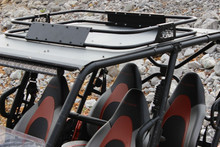What to Look Out for When Buying Can-Am Maverick R Cargo Racks?
Maverick R Cargo Rack Type
Before spending your bucks, you have to evaluate the type of rack for your Maverick R and which will satisfy your needs in the best way possible. For example, rear cargo racks offer ample space and are ideal for carrying larger gear while front racks provide easy access but may be limited in size and could affect visibility. Roof racks are great for long or bulky items while also being some of the most popular ones whereas bed extenders increase the utility of the UTV’s bed space by lengthening it. Consider your typical cargo, driving environment, and how you utilize your Maverick R to make an informed decision that enhances your off-road experience. Some of these will also affect how your Can-Am Maverick R does cornering and handling, so keep that in mind.
Mounting Solutions
When looking to buy and install cargo racks on your Can-Am Maverick R, you have to choose solutions that ensure stability and ease of installation. It’s always best to go with vehicle-specific mounting brackets and hardware that guarantee a secure fit for the rack you are going for. Consider quick-release systems for versatility, allowing for easy removal and reattachment. Ensure the mounting solution does not hinder access to essential parts of the vehicle or obstruct visibility, maintaining the Maverick R’s functionality and safety in all environments.
Cargo Capacity
Choose a cargo rack that matches your Can-Am Maverick R's needs, capable of handling your typical cargo weight without affecting the vehicle’s performance. This means that you shouldn’t go overboard with load capacity if you aren’t actually going to use it as a correct balance of weight is essential for an enjoyable drive. The Can-Am Maverick R, being a dynamic UTV, requires a careful balance between cargo capacity and maintaining its agility. It is said that common cargo capacities range from 100 to 300 pounds; consider your current and future requirements to find the perfect fit.
Build Materials and Durability
You should opt for Can-Am Maverick R cargo racks made from durable materials like steel or aluminum, each offering unique benefits and drawbacks respectively. First of all, steel racks are extremely robust but heavier and prone to corrosion, whereas aluminum racks are lighter and resistant to rust. Check for strong welding, durable plastic components where necessary, and secure mounting systems. Your chosen rack should be resilient and free of weak points to withstand off-road challenges. Whatever material you go for, make sure the finish is properly coated and protected from any imperfections your chosen metal inherently suffers from.























